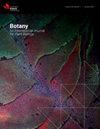Filling in the gaps: a road map to establish a model system to study developmental programmed cell death
IF 1.3
4区 生物学
Q3 PLANT SCIENCES
引用次数: 0
Abstract
Only a handful of model systems for studying programmed cell death (PCD) exist. The model Arabidopsis thaliana has generated a plethora of knowledge, but it is essential to introduce new models to broaden our understanding of the commonalities of PCD. This review focuses on Aponogeton madagascariensis (the lace plant) as a choice model to study PCD in vivo. PCD plays a key role in plant development and defence. Thus, identifying key regulators across plants is a priority in the field. The formation of perforations in lace plant leaves in areas called areoles is a striking example of PCD. Cells undergoing PCD within areoles can be easily identified from a loss of their anthocyanin pigmentation. In contrast, cells adjacent to veins, non-PCD cells, retain anthocyanins, creating a gradient of cell death. The spatiotemporal pattern of perforation formation, a gradient of cell death within areoles, and the availability of axenic cultures provide an excellent in vivo system to study mechanisms of developmental PCD. The priorities to further develop this model involve sequencing the genome, establishing transformation protocols, and identifying anthocyanin species to determine their medicinal properties. We discuss practical methodologies and challenges associated with developing the lace plant as a model to study PCD.填补空白:建立研究发育性程序性细胞死亡模型系统的路线图
只有少数几个用于研究程序性细胞死亡(PCD)的模型系统存在。拟南芥模型已经产生了大量的知识,但引入新的模型来拓宽我们对PCD共性的理解是至关重要的。这篇综述的重点是马达加斯加Aponogeton madagascarensis(花边植物)作为体内研究PCD的选择模型。PCD在植物发育和防御中起着关键作用。因此,确定各工厂的关键监管机构是该领域的优先事项。花边植物叶片在称为乳晕的区域形成穿孔是PCD的一个显著例子。乳晕内经历PCD的细胞可以很容易地从其花青素色素沉着的损失中识别出来。相反,与静脉相邻的细胞,非PCD细胞,保留花青素,产生细胞死亡的梯度。穿孔形成的时空模式、乳晕内细胞死亡的梯度以及无菌培养物的可用性为研究发育PCD的机制提供了一个极好的体内系统。进一步开发该模型的优先事项包括基因组测序、建立转化方案和鉴定花青素物种以确定其药用特性。我们讨论了与开发花边植物作为PCD研究模型相关的实用方法和挑战。
本文章由计算机程序翻译,如有差异,请以英文原文为准。
求助全文
约1分钟内获得全文
求助全文
来源期刊

Botany
生物-植物科学
CiteScore
2.20
自引率
9.10%
发文量
48
期刊介绍:
Botany features comprehensive research articles and notes in all segments of plant sciences, including cell and molecular biology, ecology, mycology and plant-microbe interactions, phycology, physiology and biochemistry, structure and development, genetics, systematics, and phytogeography. It also publishes methods, commentary, and review articles on topics of current interest, contributed by internationally recognized scientists.
 求助内容:
求助内容: 应助结果提醒方式:
应助结果提醒方式:


